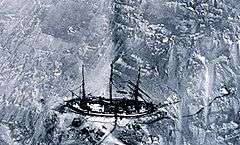Gauss expedition

The Gauss Expedition (1901–1903), was the first German expedition to Antarctica, led by Arctic veteran and geology professor Erich von Drygalski in the ship Gauss, which was named after the mathematician and physicist Carl Friedrich Gauss.
Voyage
Drygalski led the first German South Polar expedition with the ship Gauss to explore the unknown area of Antarctica lying south of the Kerguelen Islands. The expedition started from Kiel on August 11, in the summer of 1901.
Expedition
A small party of the expedition was also stationed on the Kerguelen Islands, while the main party proceeded further south. Erich von Drygalski paid a brief call to Heard Island and provided the first comprehensive scientific information on the island's geology, flora and fauna.
Despite being trapped by ice for nearly 14 months until February 1903, the expedition discovered new territory in Antarctica, the Kaiser Wilhelm II Land with the volcano Gaussberg.
Drygalski was the first to use a gas balloon in Antarctica.
Return
The expedition arrived back in Kiel in November 1903. Subsequently, Erich von Drygalski wrote the narrative of the expedition and edited the voluminous scientific data. Between 1905 and 1931, he published the 20 volumes and 2 atlases documenting the expedition.
See also
Further reading
- Drygalski, E. (1991). The German South Polar Expedition, 1901-3. Erskine Press. ISBN 1-85297-031-6
- D.T. Murphy, German exploration of the polar world. A history, 1870-1940 (Nebraska 2002).
External links
- South-Pole.com
- Report on the stay at the Kerguelens by expedition member Karl Luyken